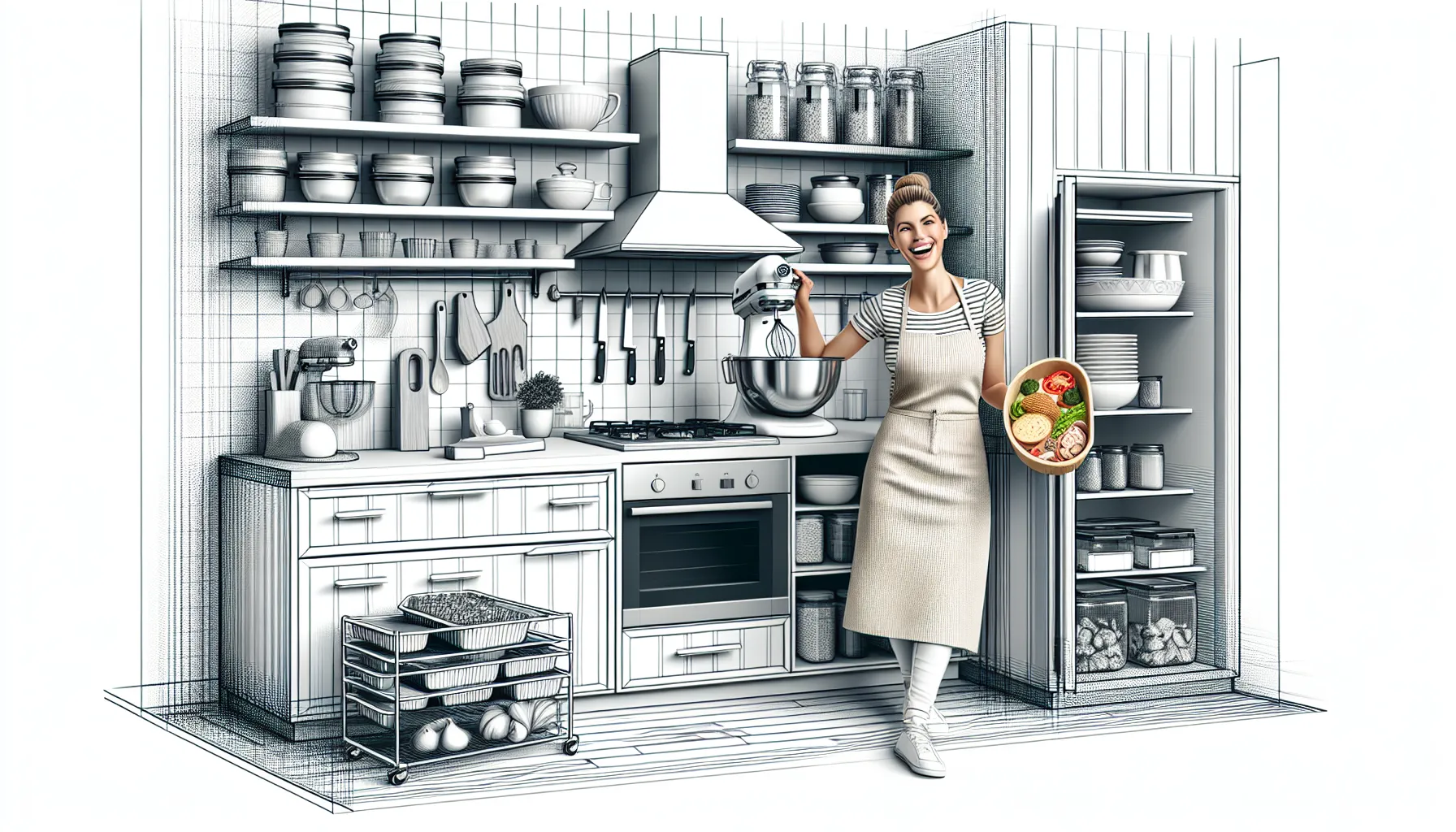Key Takeaways
- Starting a food business from home offers flexibility, lower startup costs, and the opportunity to build personal branding while fostering local community connections.
- Understanding legal requirements, including permits, health standards, and cottage food laws, is crucial to operate safely and legally.
- Defining a niche, creating a business plan, and setting a budget are essential steps for successfully planning and managing your home-based food business.
- Preparing a well-organized, efficient, and safety-compliant home kitchen is key to handling increased production and maintaining quality.
- Leveraging marketing strategies, such as building an online presence, engaging on social media, and connecting with local customers, expands your reach and boosts sales.
- Overcoming challenges like time management, competition, and maintaining customer satisfaction requires strategic planning, consistent quality, and excellent communication.
Starting a food business from home sounds like a dream, doesn’t it? Turning your passion for cooking or baking into something that could actually make money is an exciting idea. Whether it’s your signature cookies, homemade sauces, or family recipes, there’s something special about sharing your creations with others.
Benefits Of Starting A Food Business From Home
Working from home in a food business creates flexibility with schedules. I can choose my operating hours and structure my workload around personal commitments or peak demand times.
Launching from home requires lower startup costs. There’s no need to pay for commercial space, reducing expenses like rent, utilities, and additional maintenance fees.
A home-based setup allows for personalized branding. I get to showcase my unique creations, whether it’s artisanal jams, custom cakes, or gourmet meal kits, building a brand that reflects my passion and expertise.
Operating locally helps build strong community connections. Selling to neighbors and nearby customers promotes trust and loyalty, often leading to word-of-mouth referrals.
Home operations enable gradual scaling. I can start small, refine recipes, and expand based on increasing demand without overwhelming financial pressure.
Legal Requirements And Regulations

Starting a food business from home means complying with specific legal requirements. These regulations ensure your business operates safely and stays within the law.
Licenses And Permits
Every local government has rules about food businesses. I checked with my city or county offices to determine what permits were necessary. Common licenses include business operation permits and food handler certificates. If I planned to ship products, I ensured I had state or federal licensing if required.
Health And Safety Standards
Home food businesses must meet health department standards to protect customers. I maintained a clean kitchen, used proper food storage techniques, and regularly sanitized my workspace. Some states required inspections of my kitchen to make sure it complied with safety protocols.
Understanding Cottage Food Laws
Cottage food laws allow people to sell specific homemade goods without needing a commercial kitchen. I researched my state’s cottage food regulations to know the types of food I could legally sell, often non-perishable items like baked goods or jams. Some laws placed limits on annual sales revenue or required detailed labeling of products with ingredient lists and allergen information.
Planning Your Home-Based Food Business

Successful planning is key when starting a food business from home. I focus on defining my goals, understanding the market, and managing resources effectively.
Identifying Your Niche
Choosing a niche helps narrow the focus and target a specific audience. I evaluate my strengths, such as baking cakes or crafting artisanal jams, and research local demand. For example, gluten-free desserts or organic snacks often attract health-conscious customers. A well-defined niche also shapes branding and marketing efforts.
Creating A Business Plan
A solid business plan acts as a roadmap. I outline the products I’ll sell, my target audience, and pricing strategies. I also include marketing plans, such as social media promotions or collaborations with local farmers’ markets. Setting achievable short-term goals and projecting potential challenges keeps the plan realistic and actionable.
Setting A Budget
Budgeting ensures my expenses align with expected revenue. I start by listing initial costs like kitchen tools, packaging, and licensing fees. I then estimate monthly expenses, such as ingredients and utilities. Tracking these costs against sales helps me maintain profitability and allocate funds effectively for growth.
Setting Up Your Home Kitchen For Business

Preparing a home kitchen for a food business involves more than just cooking. I focus on creating a space that meets safety standards and maximizes efficiency.
Equipment And Supplies
I ensure my kitchen has the right tools to handle increased production. For baking, this might include stand mixers, silicone mats, and precise measuring tools. For cooking, I might need larger pots, high-quality knives, and food processors. If I package products, I invest in a vacuum sealer, labels, and proper storage containers. Disposable gloves, cleaning supplies, and food-safe storage bags are also essential for maintaining hygiene and safety.
Organization And Workflow Efficiency
I arrange my workspace to streamline production and reduce delays. Designating zones for cleaning, prepping, cooking, and packaging helps me stay organized. I store frequently used items, like utensils and ingredients, within easy reach. Labeling containers and creating an inventory list ensures I never run out of critical supplies. By setting up a clear workflow, I reduce wasted time and maintain consistency in every batch I prepare.
Marketing And Selling Your Homemade Food
Sharing homemade food with more customers involves effective marketing strategies. Focusing on visibility online and in the local community can expand your reach and build trust.
Building An Online Presence
Establishing an online presence helps customers discover my products easily. I created a simple website featuring high-quality photos, detailed product descriptions, and easy ordering options. Including a “story” page shows the personal aspect of my business, highlighting my passion and products. Listing on local food directories or apps adds another layer of exposure. For payment, I integrated secure online payment gateways to ensure transactions are seamless.
Attracting Local Customers
Local customers often appreciate a personal touch. To connect with them, I distribute flyers in nearby neighborhoods, deliver samples to local cafes, and participate in farmers’ markets or community fairs. Joining local Facebook groups and neighborhood forums also helps showcase my products. Partnering with nearby businesses, like coffee shops willing to sell my baked goods, strengthens my community presence.
Leveraging Social Media Platforms
Social media drives engagement and promotes my food business. I post visually appealing content on Instagram, such as photos of fresh batches or behind-the-scenes reels showing my kitchen process. Sharing quick recipe videos with my products keeps my audience interested. Promotions, such as limited-time discounts on Facebook or highlighting customer reviews, attract followers. Interacting in the comments and regularly updating stories builds community trust and fosters relationships.
Challenges And How To Overcome Them
Running a home-based food business brings unique challenges, but addressing them strategically can pave the way for success. By planning proactively, I’ve found ways to navigate common obstacles effectively.
Time Management
Balancing production, marketing, and personal responsibilities can feel overwhelming. I create a detailed daily schedule to allocate time for each task, from cooking to social media engagement. Batch cooking and prepping ingredients in advance save hours during busy periods. Tools like calendars or task management apps help me stay on track.
Delegating tasks has also proven essential. Whether it’s hiring part-time help for packaging or outsourcing delivery, it ensures I focus on core activities. When managing multiple roles, prioritizing high-impact tasks guarantees progress without burning out.
Dealing With Competition
Standing out in a competitive market takes effort. I distinguish my food business by offering unique products or exceptional customer service. For example, I focus on niche items like vegan pastries or custom gift boxes, creating an edge over generic options.
I analyze competitors in the area to identify gaps in offerings or weaknesses in their branding. This research allows me to position my business effectively. Consistent engagement with customers through social media and local events also strengthens my brand’s presence. Building lasting relationships with loyal customers offsets competitive pressures.
Customer Satisfaction
Satisfied customers drive growth in any food business. Maintaining quality in every batch is my top priority. Feedback from customers, whether through online reviews or direct conversations, helps me understand expectations and adjust as needed.
Clear communication is equally important. I inform customers about product ingredients, allergen details, and order updates, ensuring transparency. Taking time to personalize services, like including a thank-you note with orders, fosters trust and loyalty. Addressing any complaints promptly and professionally strengthens relationships and keeps customers returning.
Conclusion
Starting a food business from home is an exciting journey that combines creativity, passion, and the joy of sharing your talent with others. It’s a chance to turn your love for food into something meaningful and rewarding while working on your own terms.
With thoughtful planning, attention to detail, and a commitment to quality, you can build a business that not only stands out but also brings happiness to your customers. Remember to stay adaptable, keep learning, and embrace the challenges as opportunities for growth.
Your kitchen can be the heart of a thriving business, and with the right mindset, there’s no limit to what you can achieve.
Frequently Asked Questions
What is a home-based food business?
A home-based food business involves preparing and selling food products from your home kitchen. It allows entrepreneurs to transform their passion for cooking or baking into a profitable venture while enjoying lower startup costs, flexible schedules, and personalized branding opportunities.
What licenses and permits do I need to start a home-based food business?
The specific licenses and permits vary by state or locality, but commonly include a business license, a food handler’s permit, and adherence to cottage food laws. Research your local regulations to ensure compliance with health, safety, and labeling requirements.
What are cottage food laws?
Cottage food laws regulate small-scale food producers who sell homemade products like baked goods, jams, and pickles without needing a commercial kitchen. These laws outline the permissible food items, sales limits, and labeling requirements for a home-based food business.
How can I define a niche for my home food business?
To define a niche, identify a specific target audience and create unique offerings that meet their needs. For example, focus on gluten-free desserts, vegan treats, or organic snacks to cater to health-conscious consumers and differentiate from competitors.
How do I create a business plan for my home food business?
Your business plan should include details about your products, target audience, pricing strategy, marketing efforts, and financial goals. Outline how you plan to sell your food, whether online, at farmers’ markets, or within your community, to ensure sustainable growth.
What equipment is essential for a home kitchen food business?
Essential equipment for a home-based food business includes high-capacity appliances such as stand mixers, larger pots, vacuum sealers, food-safe storage containers, and labeling tools. Ensure your kitchen is organized to improve workflow efficiency and maintain hygiene standards.
How can I market my homemade food products effectively?
Create an online presence with a website showcasing your products, and use social media to engage with potential customers. Distribute flyers, offer free samples, participate in local community events, and list your business in local food directories for increased visibility.
What are some challenges in running a home-based food business?
Common challenges include time management, competition, and adhering to regulations. To overcome them, develop a detailed schedule, batch-cook for efficiency, offer unique products, provide excellent customer service, and delegate tasks when necessary.
How can I stand out in a competitive food market?
Focus on offering unique, high-quality products and exceptional customer service. Analyze competitors to identify gaps or opportunities and build strong relationships with your customers by personalizing services and consistently delivering on expectations.
How do I track the profitability of my home food business?
Track expenses, revenue, and sales regularly. Maintain a clear budget, analyzing costs like ingredients, packaging, and marketing against your income. Adjust pricing or production strategies as needed to ensure a sustainable and profitable business.

